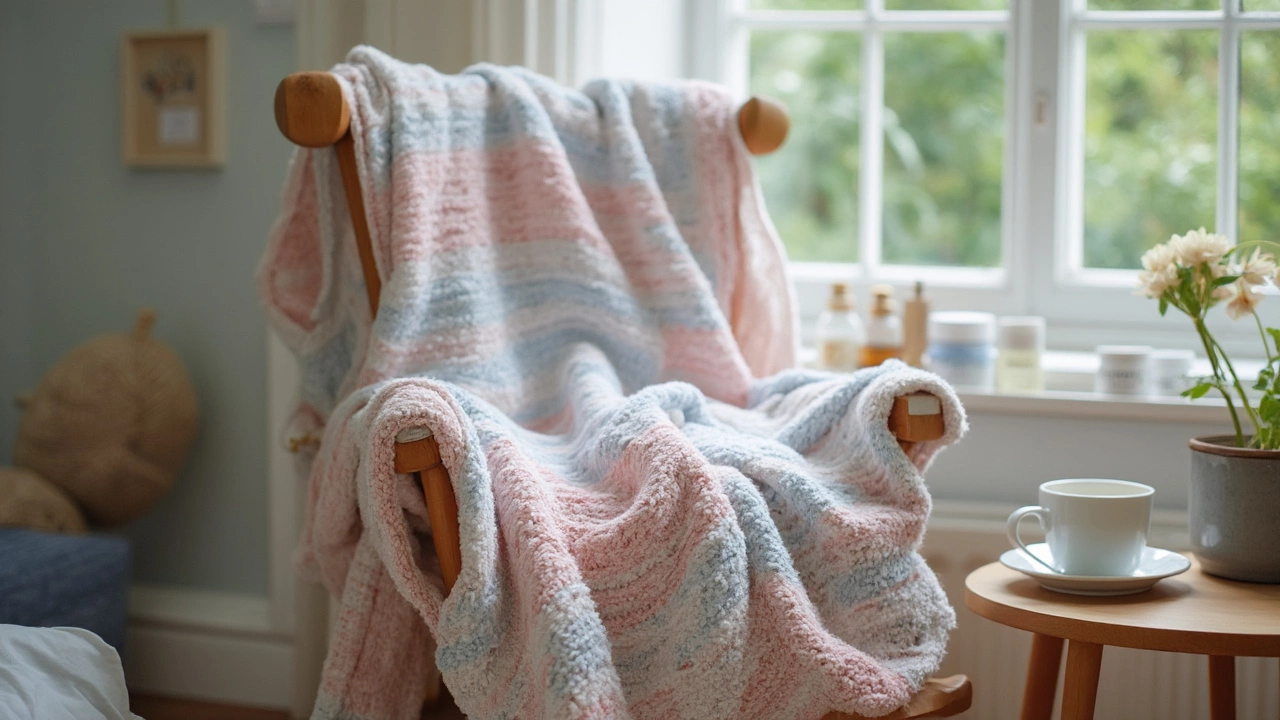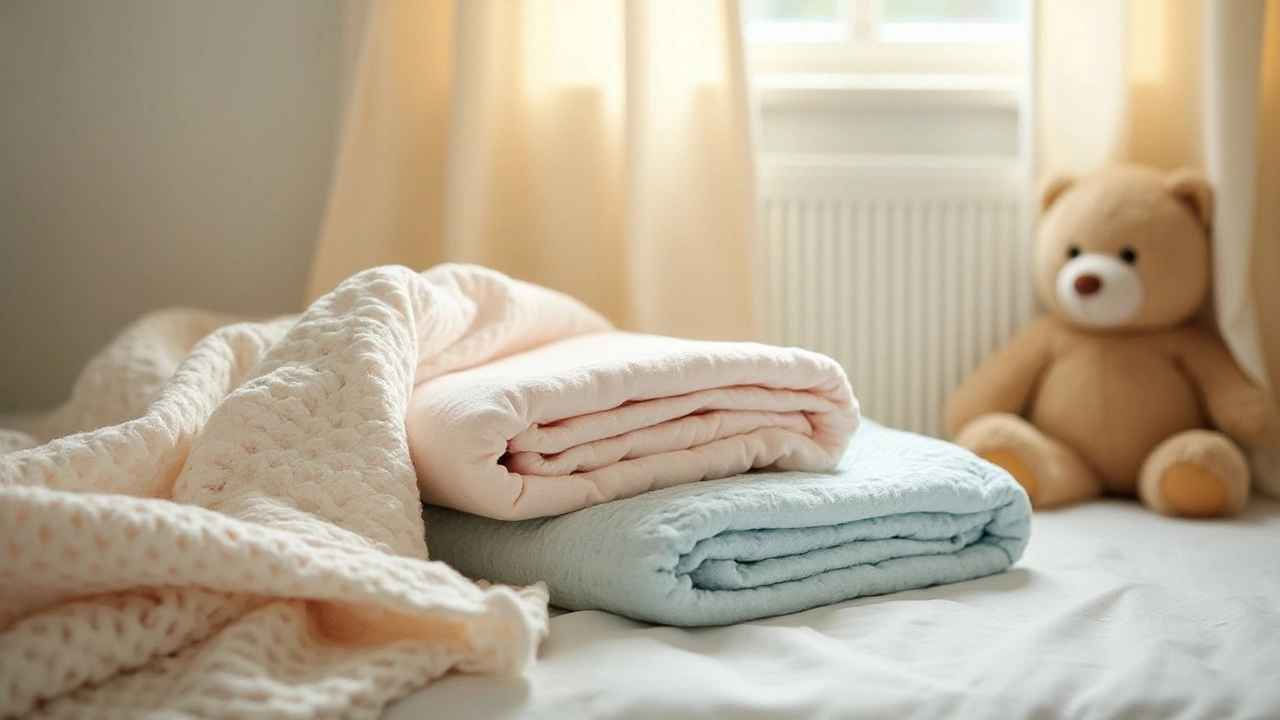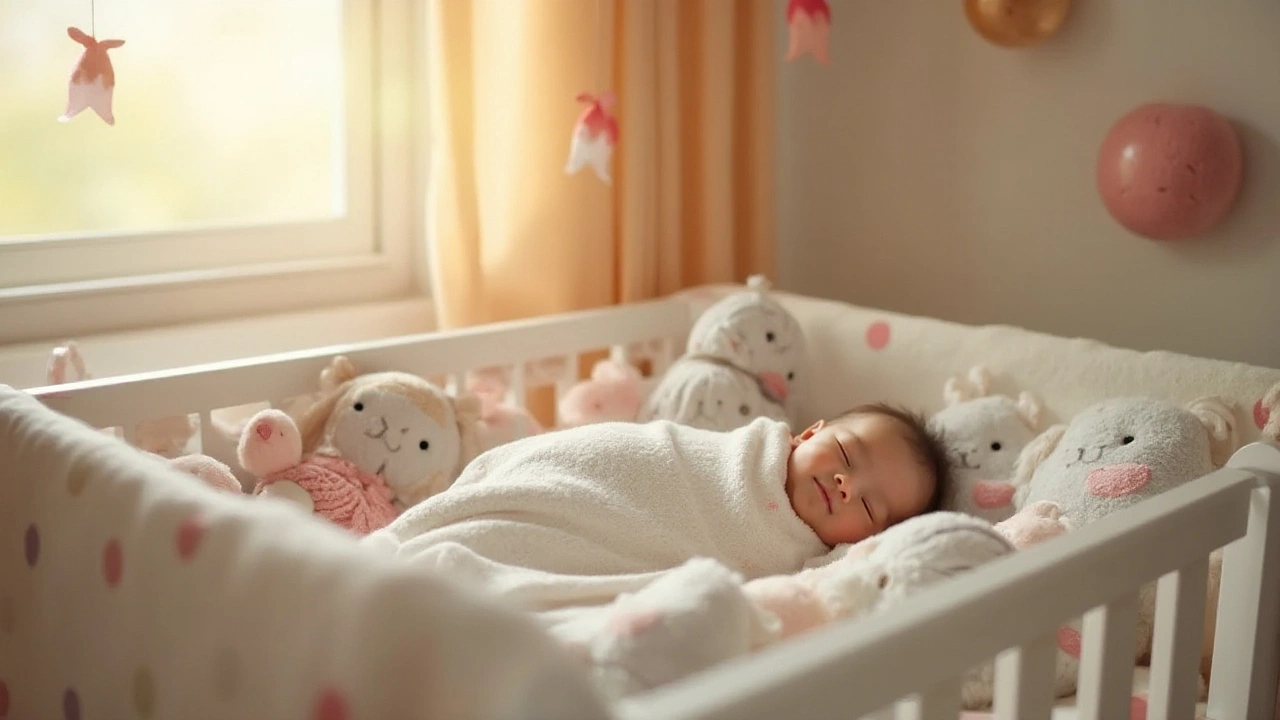Why Do Hospitals Use Baby Blankets? The Real Story Behind the Stripes

You've probably seen it in every baby photo—those blue and pink striped blankets wrapped around newborns. Hospitals don’t just pick any random blanket off the shelf. There’s actually a reason most hospitals across North America use the same design, and it's way more practical than you might expect.
These blankets, known as "Kuddle-Up" by the company Medline, are basically the workhorse of baby care. Hospitals order them by the thousands because they’re cheap, super sturdy, and easy to wash and reuse. No frills, no soft pastel prints, just a blanket that does its job—keeping babies warm and swaddled from their very first seconds.
- The Iconic Hospital Baby Blanket
- Why the Colors and Stripes?
- What Makes Hospital Blankets Special?
- Swaddling and Newborn Comfort
- From Hospital to Home: Buying Your Own
- Tips for Using Baby Blankets Safely
The Iconic Hospital Baby Blanket
Walk into a maternity ward just about anywhere in North America, and you’ll spot the same blanket: soft white, with pink and blue stripes along the sides. This isn’t a fluke or just a trend hospitals are following for fun. The baby blankets you see wrapped around tiny new arrivals mostly come from one place—Medline’s Kuddle-Up blankets. Hospitals have been using the exact same design since the 1950s.
These blankets are made of 100% cotton flannel and measure about 30 by 40 inches. They aren’t huge, but they’re the perfect size for swaddling a newborn. Hospitals love them because they’re tough, easy to sanitize with hospital laundry systems, and can be used again and again without falling apart. That means less fuss and less cost for the hospital, and a comfy wrap for every baby born there.
The company behind the most popular version—Medline—ships out millions of these blankets every year. To give you an idea of just how many are in circulation, check out these estimates:
| Year | Estimated Blankets Distributed (USA) |
|---|---|
| 2010 | 13 million |
| 2020 | 20 million |
They’re so much a part of newborn life that some families even ask to bring their hospital blanket home as a keepsake. Sometimes, you’ll even see parents searching online to buy the exact “hospital blanket” they remember from their first days with their baby.
Why the Colors and Stripes?
There's a reason nearly every newborn goes home in the same blue-and-pink striped blanket. It's not a fashion choice—it's all about tradition, visibility, and practicality. The iconic stripes go back to the 1950s when the Kuddle-Up blanket was designed to be instantly recognizable in any hospital nursery. Blue and pink were picked to be gender-neutral, sidestepping the usual 'blue for boys, pink for girls' debate. With both colors on one blanket, the hospital can use them for every baby—simple, efficient, and no confusion.
The stripes themselves aren't just for looks. Those clean, bold lines help workers easily spot a blanket in piles of laundry, making sorting and inventory a breeze for hospital laundry staff. No one has to fish through a mountain of fabrics hunting for baby wraps—striped ones pop right out. Plus, the colors don’t fade easily, even after dozens of rounds through the industrial washers.
- The pink-and-blue striping is unique to Medline's Kuddle-Up line, which dominates the U.S. hospital market.
- Hospitals stick with these blankets because their look signals "newborn care" like nothing else—and staff know exactly what they're grabbing.
- Both colors represent inclusivity—no need to worry about matching blanket color to the baby's gender moments after birth.
Just how common are these blankets? Check this out:
| Yearly Production (estimated) | Color | Design |
|---|---|---|
| Over 1.5 million | Blue/pink stripes | Medline Kuddle-Up |
If you ever wondered why every baby has nearly the same stripes, it just comes down to what works best in fast-paced hospitals. The look is a bonus—it's the blanket's reliability that keeps it around year after year. The baby blankets with blue and pink stripes are pretty much the gold standard in newborn care—for reasons that go beyond just looking cute in the first photo.
What Makes Hospital Blankets Special?
There’s a reason you spot the same blanket pattern in every maternity ward. These hospital baby blankets aren’t just a style choice—they’re built with specific needs in mind. First, durability tops the list. Most are made from a strong, thick cotton flannel designed to survive hundreds of sanitizing washes without coming apart. It’s all about reusability and hygiene. That’s why hospitals can keep costs down without compromising on cleanliness.
Let’s talk about size. The standard hospital baby blanket measures about 30 inches by 40 inches. That’s basically the perfect dimension for swaddling a newborn snugly but not too tightly. It’s big enough to wrap securely, but not so large that you end up with yards of extra fabric getting in the way.
Another thing: the fabric isn’t super fluffy on purpose. It’s soft enough for babies, but not slippery or stretchy, so you can get a good, strong swaddle that stays put. The classic blue and pink stripes aren’t for looks—they help staff easily spot stains and messes on the white background, so no soiled blanket slips by unnoticed.
If you’re a numbers fan, check this out:
| Feature | Benefit |
|---|---|
| Material | 100% cotton flannel, strong and warm |
| Size | About 30” x 40” (76 x 102 cm), ideal for swaddling |
| Washes Withstand | Up to 100+ high-heat washes |
| Stripes | Blue-pink pattern improves stain detection |
And just for the record, these baby blankets are all about practicality, not just nostalgia. They’re simple, easy to use, and keep newborns safe and warm at a time when their body temperature drops fast after birth. That’s why you won’t see hospitals swapping them for cute, trendy designs—these guys just work better.

Swaddling and Newborn Comfort
Swaddling isn’t just an old habit—it’s science-backed comfort for newborns. Wrapping a baby snugly mimics the coziness of the womb, and it helps calm newborns by controlling their startle reflex. That’s why those baby blankets you see in hospitals are the go-to: they’re just the right thickness for a tight, safe swaddle.
Researchers have found that swaddled babies tend to cry less and sleep longer, especially in those hectic early days. The American Academy of Pediatrics (AAP) has pointed out that swaddling—if done correctly—can help soothe fussy babies and may even lower the risk of sudden infant death syndrome (SIDS) when done with safe sleep practices.
Want the quick facts on how swaddling stacks up? Check out the numbers:
| Benefit | What Studies Show |
|---|---|
| Sleep Duration | Swaddled babies sleep 30% longer on average during naps* |
| Soothing | Babies showed up to 28% less crying when swaddled |
| Startle Reflex | Swaddling reduces sudden jerky movements that wake newborns |
*Data from the Journal of Pediatrics, 2017
So, how do you actually swaddle like a pro? Here’s a simple step-by-step you can use at home, whether you have the classic hospital blanket or something similar:
- Lay the blanket flat like a diamond. Fold the top corner down, making a straight edge.
- Place baby on their back, shoulders just below the fold.
- Hold baby’s arms straight at their sides. Pull one side of the blanket over and tuck under.
- Fold up the bottom corner, tucking near the shoulders if needed.
- Bring the other side of the blanket across, securing the swaddle but not too tight—babies should still be able to move their hips.
One key thing: Always put your baby on their back to sleep, swaddled or not. And stop swaddling once they show signs of rolling over, usually by two months or earlier.
This simple trick with a humble hospital blanket can be the difference between a frazzled night and a few hours of peace for new parents—and a cozy start for babies.
From Hospital to Home: Buying Your Own
A lot of new parents want that familiar striped hospital look at home, and you can totally get it—no special connections or medical badges needed. The same companies that hospitals buy from, like Medline and Halo, actually sell to regular shoppers online. You can find the original cotton flannel hospital blanket (yep, the famous one with the blue and pink stripes) on sites like Amazon or even direct through medical supply stores.
Why do people want these over something more stylish? For starters, they’re tough as nails compared to typical baby blankets, and they don’t pill or shrink after a couple of washes. It’s smart—buy four or five, and you’ll have spares while one’s in the laundry.
Here’s a quick real-life fact: one Medline hospital blanket sells online for around $3–5 each if you buy a pack. Compare that to designer baby blankets, and you see why parents stock up. Plus, it’s not just for wrapping up babies at nap time or bedtime. People use these for burp cloths, tummy time, car seat covers—pretty much any baby mess or spill. Just toss one in the diaper bag and you’re set.
Here’s a direct comparison between hospital blankets and typical store-bought baby blankets:
| Feature | Hospital Blanket | Store-Bought Blanket |
|---|---|---|
| Material | Cotton flannel | Varies (cotton, polyester, blends) |
| Durability | High (wash hundreds of times) | Medium to low |
| Size | 30x40 inches standard | Ranges (often smaller) |
| Price | About $3–$5 each | $10–$50, depending on brand |
| Design | Striped, classic | Various prints, colors |
One tip—a genuine hospital blanket usually uses the slightly scratchier, thicker cotton flannel and has blue and pink stripes at both ends. If you want the real deal, look for the baby blankets with "Kuddle-Up" in the title. Also, always wash them first at home because they’ll soften up a lot after the first few cycles, and you’ll know for sure any factory dust is gone.
Tips for Using Baby Blankets Safely
Baby blankets are everywhere, but using them right actually helps keep babies safe and comfortable. There’s a bit of science behind why swaddling helps newborns: it mimics the snug feeling inside the womb, which calms most babies and helps with sleep. That said, you’ve got to use them the right way—otherwise, they can be more trouble than they’re worth.
"Always place your baby on their back to sleep, and keep loose bedding and soft objects away from their face to help prevent SIDS," says the American Academy of Pediatrics.
To make things simple, here’s what you need to do to keep your baby safe with blankets, especially in their first year:
- Swaddle only until your baby can roll over, usually around two months old. After that, blankets can be risky.
- Don’t let blankets, even hospital ones, cover your baby’s face or head—babies can’t push them away if they slip up.
- Only use light, breathable blankets for swaddling—never use heavy quilts or knitted blankets for sleep.
- Keep the crib free from stuffed animals, pillows, and extra bedding. One snug swaddle is enough.
- If your baby wiggles out of their swaddle, switch to a wearable blanket or sleep sack instead.
Hospitals know what they’re doing when they stick to these cotton baby blankets—they’re made to hold up to tons of washing, but aren’t too thick or warm. Check out this quick comparison to see why these blankets work so well:
| Type of Blanket | Breathability | Recommended Age for Sleep | Easy to Wash? |
|---|---|---|---|
| Hospital Cotton Blanket | High | Newborn (Swaddling) | Yes |
| Heavy Quilted Blanket | Low | Older than 12 months | Sometimes |
| Knitted/Crochet Blanket | Low | Supervised only | No |
Doctors strongly recommend room temperature stays between 68-72°F (20-22°C)—so if the room feels chilly to you, maybe add a layer, but when in doubt, check your baby’s chest or back, not their hands or feet, for warmth. Never wrap a baby up so tightly they can’t move their hips or legs, which is important for proper development. If you’re ever unsure, reach out to your pediatrician or check guidelines from trusted sources like the American Academy of Pediatrics.

